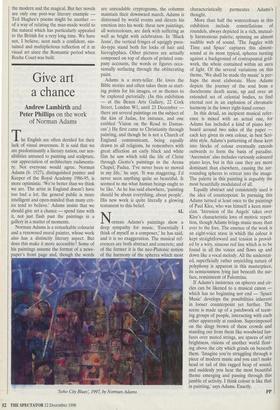Give art a chance
The English are often derided for their lack of visual awareness. It is said that we are predominantly a literary nation, our sen- sibilities untuned to painting and sculpture, our appreciation of architecture rudimenta- ry. Not everyone would agree. Norman Adams (b. 1927), distinguished painter and Keeper of the Royal Academy 1986-95, is more optimistic. 'We're better than we think we are. The artist in England doesn't have too bad a lot; the general public is more intelligent and open-minded than many crit- ics tend to believe.' Adams insists that we should give art a chance — spend time with it, not just flash past the paintings in a gallery in a matter of moments.
Norman Adams is a remarkable colourist and a renowned mural painter, whose work also has a distinctly literary aspect. But does this make it more accessible? Some of his paintings assume the format of a news- paper's front page and, though the words are unreadable cryptograms, the columns maintain their downward march. Adams is distressed by world events and directs his emotion into his work: these new paintings, all watercolours, are dark with suffering as well as bright with celebration. In 'Black Jesus', the vertical fringes of squiggly pseu- do-type stand both for locks of hair and hieroglyphics. Other pictures are actually composed on top of sheets of printed com- pany accounts, the words or figures occa- sionally surfacing through the obliterating paint.
Adams is a story-teller. He loves the Bible stories and often takes them as start- ing points for his images, or as themes to be explored pictorially. (In this exhibition — at the Beaux Arts Gallery, 22 Cork Street, London Wl, until 23 December there are several paintings on the subject of the kiss of Judas, for instance, and one entitled 'Vision on the Road to Damas- cus'.) He first came to Christianity through painting, and though he is not a Church of England communicant, being equally drawn to all religions, he remembers with great affection an early black and white film he saw which told the life of Christ through Giotto's paintings in the Arena Chapel, Padua. 'I've never been so moved in my life,' he says. 'It was staggering. I'd never seen anything quite so beautiful. It seemed to me what human beings ought to be like.' As he has said elsewhere, 'painting should be about everything, about people'. His new work is quite literally a glowing testament to this belief.
AL Norman Adams's paintings show a deep sympathy for music. 'Essentially I think of myself as a composer,' he has said, and it is no exaggeration. The musical ref- erences are both abstract and concrete; and of the former it is the neo-Platonic notion of the harmony of the spheres which most `Soho City Blues', 1997, by Norman Adams characteristically permeates Adams's thought.
More than half the watercolours in this exhibition include constellations of roundels, always depicted in a rich, mutual- ly harmonious palette, spinning an almost audible web of sound. 'The Juggler with Time and Space' captures this almost- sound at its most typical, spheres turning against a background of contrapuntal grid- work, the whole contained within an aura of light. Of the several variations on this theme, 'We shall be made thy music' is per- haps the most elaborate. Here Adams depicts the journey of the soul from a duochrome death scene, up and over an extended set of celestial bodies, to find eternal rest in an explosion of chromatic harmony in the lower right-hand corner.
In this detail, an incipient musical refer- ence is mixed with an actual one, for Adams has included a kind of piano key- board around two sides of the paper each key given its own colour, in best Scri- abin style. Adams's patterning of these keys into blocks of colour eventually extends outwards to form the basis of paradise. `Ascension' also includes variously coloured piano keys, but in this case they are more dominant than elsewhere, causing the sur- rounding spheres to retreat into the image. The palette in this painting is arguably the most beautifully modulated of all.
Equally abstract and consistently used is the idea of counterpoint. In pursuing this Adams turned at least once to the paintings of Paul Klee, who was himself a keen musi- cian. 'Intrusion of the Angels' takes over Klee's characteristic love of motivic repeti- tion, though Adams brings music more than ever to the fore. The essence of the work is an eight-voice stave in which the colour is kept straightforward and tension is provid- ed by a wiry, sinuous red line which is to be found in all the voices and flows up and down like a vocal melody. All the understat- ed, superficially rather unyielding nature of polyphony is apparent in this masterpiece, its sensuousness lying just beneath the sur- face, reminiscent of Palestrina.
If Adams's insistence on spheres and cir- cles can be likened to a musical canon which has no beginning nor end — 'Space Music' develops the possibilities inherent in looser counterpoint yet further. The scene is made up of a patchwork of teem- ing groups of people, interacting with each other apparently at random. Superimposed on the dingy brown of these crowds and standing out from them like woodwind fan- fares over muted strings, are spaces of airy brightness, visions of another world float- ing above the city which grinds on beneath them. 'Imagine you're struggling through a piece of modem music and you can't make head or tail of this ragged heap of sound, and suddenly you hear the most beautiful theme emerging and passing through this jumble of activity. I think colour is like that in painting,' says Adams. Exactly.
PP










































































 Previous page
Previous page